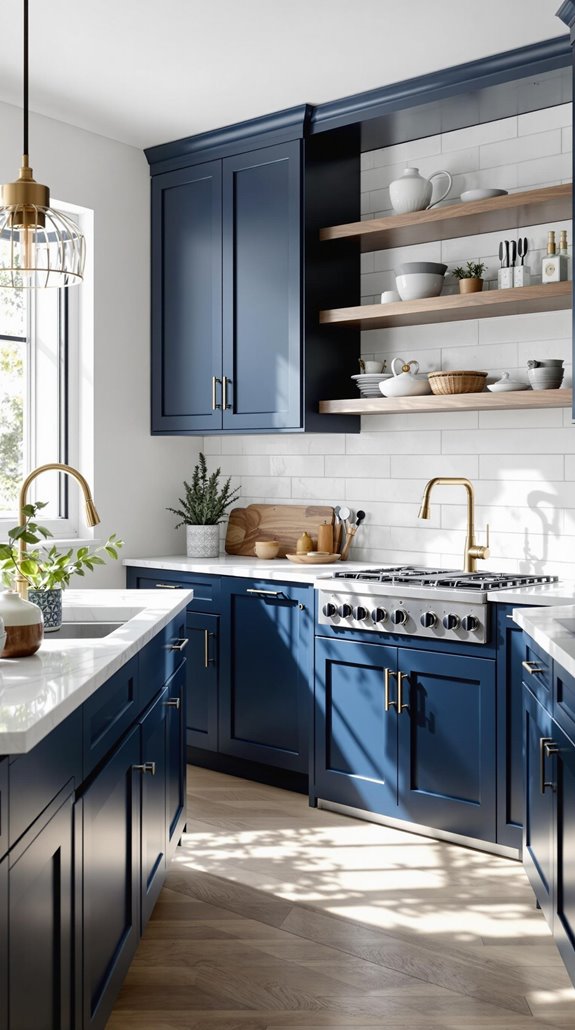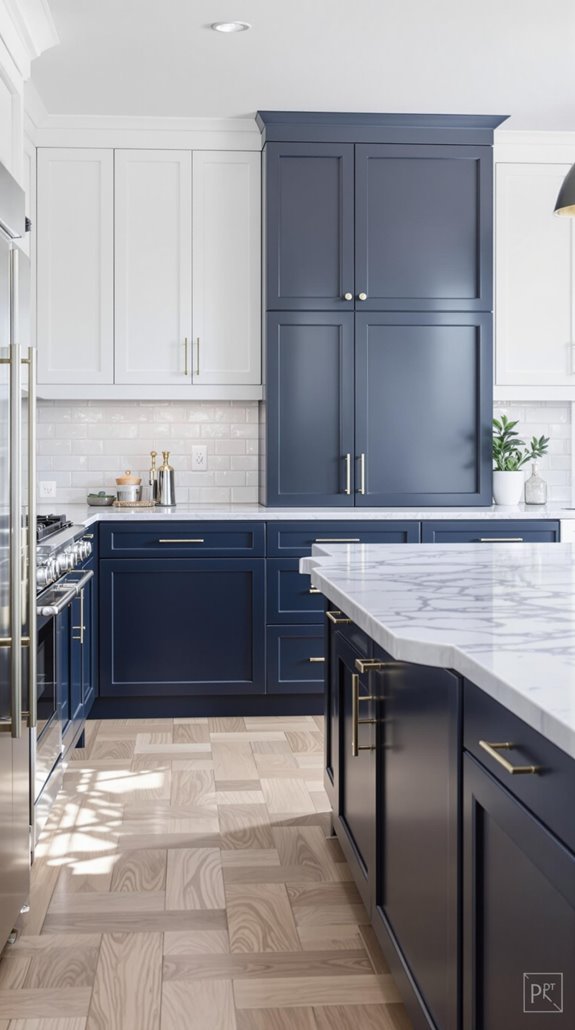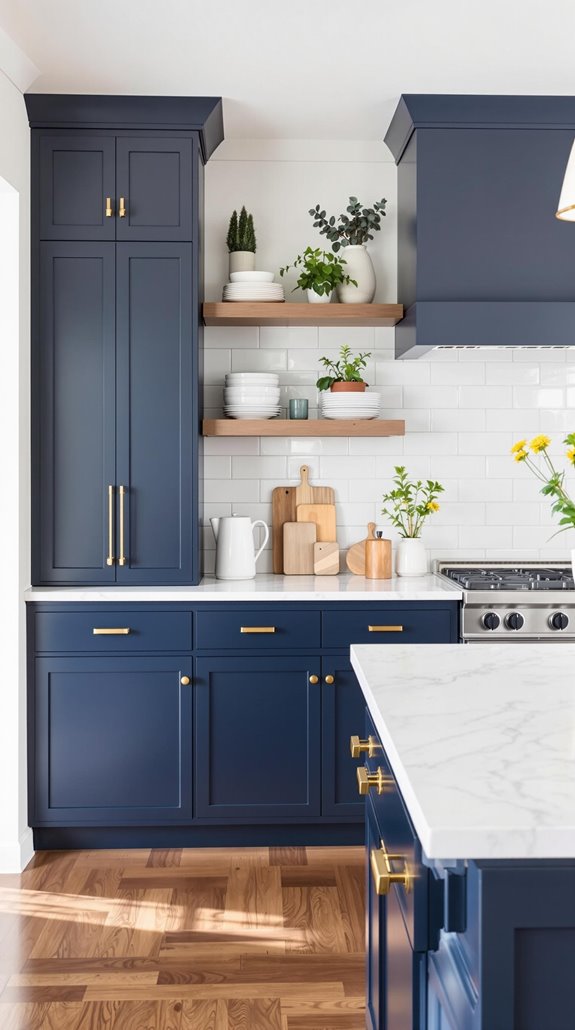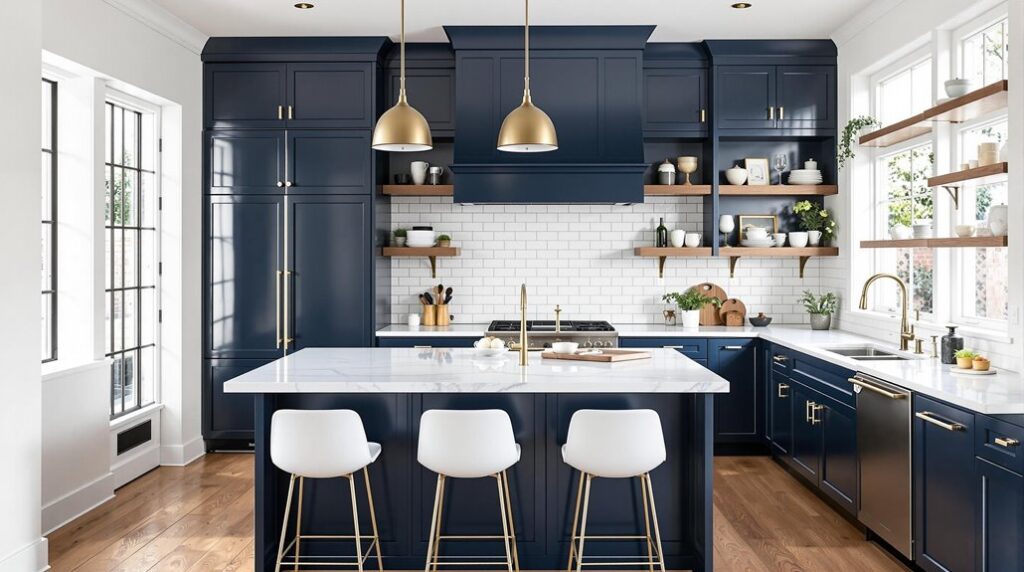I’ve designed dozens of kitchens over the years, and there’s one color combination that consistently delivers both sophistication and staying power: navy and white. While other trends come and go, this pairing creates a foundation that won’t look dated in five years. The secret isn’t just choosing these colors—it’s understanding how to balance them strategically. Let me show you the specific techniques that’ll transform your kitchen into a space that’s both striking and endlessly practical.
Key Takeaways
- Navy blue ranks as the second most popular kitchen color, chosen by 63% of design professionals for its sophisticated and timeless appeal.
- Navy lower cabinets paired with white uppers create visual balance, providing depth while maintaining an airy, open feel.
- White quartz or marble countertops paired with brass hardware enhance the navy-white combination for elegant contrast and durability.
- This color scheme adapts seamlessly across design styles, from coastal to modern, traditional to rustic kitchen aesthetics.
- Strategic placement includes navy on primary work walls or islands as bold accents, with white perimeter cabinets for cohesive flow.
Why Navy Blue Dominates 2025 Kitchen Color Trends

Navy blue’s surge to the forefront of kitchen design isn’t just another passing trend—it’s a calculated shift that’s reshaping how we approach color in our most-used spaces. I’ve watched 63% of design professionals choose blue as their second most popular kitchen color, with 35% of new remodels featuring dark cabinets like navy.
What makes navy brilliant for your project? It’s technically a neutral—pairing effortlessly with brass, chrome, or silver finishes while giving you complete freedom to mix metals confidently. You’ll get that sophisticated, timeless appeal that works whether you’re going modern or traditional.
The color reflects our collective move toward nature-inspired palettes, evoking ocean depths while maintaining the versatility you need for long-term design success. This shift aligns with the broader trend away from all-white kitchens toward more expressive, personality-driven spaces that tell your unique story.
Creating Perfect Balance With Navy Lower and White Upper Cabinets
When you’re designing a kitchen that needs both drama and openness, splitting your cabinetry between navy lowers and white uppers creates the perfect visual equilibrium. I’ve found this approach anchors your space with navy’s depth while maintaining an airy feel through light-reflective white uppers. Budget-friendly renovations can enhance the overall look without breaking the bank.
You’ll want to bridge these contrasting tones with brass hardware and natural materials like walnut accents. For your backsplash, white subway tiles streamline the look, while patterned options add energy without clashing. This layout works brilliantly for functionality too – store daily essentials in accessible navy bases and less-used items in white uppers.
Complete your design with warm pendant lights and open wood shelving to break rigidity while keeping your color story cohesive. The navy blue’s sophisticated look offers exceptional contrast and depth that enhances the overall elegance of your kitchen space.
Strategic Layout Ideas for Navy and White Two-Tone Designs

Since your kitchen’s layout determines how effectively navy and white elements work together, I’ll show you specific placement strategies that maximize both visual impact and functionality.
I recommend placing navy cabinets on your lower level to ground the space while keeping white uppers to maintain an airy feel. This creates natural visual weight distribution that feels balanced and intentional.
For galley kitchens, alternate navy and white on opposite walls to create rhythm without overwhelming the narrow space. In L-shaped layouts, use navy on your primary work wall and white on the secondary wall to establish a clear focal point.
Island placement offers another opportunity—I suggest navy base cabinets with white perimeter uppers, or reverse this pattern to make your island the dramatic centerpiece that anchors your entire design scheme. Navy blue islands serve as bold accents in bright kitchens, providing a focal point for everyday activities while grounding the overall design.
Essential Materials and Finishes That Enhance Navy and White Kitchens
While your color scheme provides the foundation, the materials and finishes you select will ultimately determine whether your navy and white kitchen feels cohesive or disjointed.
I’ll guide you through the essential material choices that make navy and white kitchens truly shine. For countertops, white quartz creates stunning contrast while offering durability, though marble adds luxury if you’re willing to maintain it. Wood surfaces introduce warmth that prevents the space from feeling cold, and high-quality materials can elevate the overall aesthetic and longevity of your kitchen.
Cabinet finishes matter tremendously—matte absorbs light and hides fingerprints, while gloss reflects light in smaller spaces. Hardware metals like brass or gold warm up navy cabinets beautifully, though chrome works for contemporary looks. Navy’s timeless appeal ensures your kitchen design will remain stylish for years to come.
For taps, brushed brass creates sophisticated contrast, while matt black delivers bold drama. Don’t overlook accent materials like exposed wood shelves or matte black appliances that break monotony.
Adapting Navy and White Color Schemes Across Different Design Styles

The beauty of navy and white lies in its remarkable adaptability—this classic pairing transforms effortlessly across design styles, from coastal charm to moody contemporary drama.
I’ll show you how to master this versatility. For coastal kitchens, pair white uppers with navy bases, adding rope handles and subway tiles. Traditional spaces shine with marble countertops and brass hardware creating refined elegance. Modern designs demand high-gloss navy finishes and minimalist hardware for sleek sophistication. The finish choice significantly influences how light interacts with your cabinetry, with matte surfaces creating intimate warmth while glossy options brighten and open up spaces. In addition, integrating effective use of natural light can enhance the overall ambiance of your kitchen design. Rustic kitchens benefit from butcher block countertops and natural wood elements that warm navy cabinetry. Moody contemporary spaces use deep blue backsplashes with walnut finishes and black stone countertops for dramatic impact.
Each style requires strategic material choices—your success depends on understanding these key combinations.
Conclusion
I’ve shown you the essential tools and strategies for executing a navy and white kitchen design. Now it’s your turn to implement these proven techniques. Start by mapping your cabinet layout, then select your materials and finishes systematically. Remember, this isn’t just about following trends—you’re creating a functional workspace that’ll serve you for decades. Grab your measuring tape, compile your material list, and transform your kitchen into this timeless design.
References
- https://www.bhg.com/kitchen-color-trends-2025-8759642
- https://www.nar.realtor/blogs/styled-staged-sold/kitchen-trends-2025-whats-in-whats-out
- https://cabinetcurestriangle.com/blog/kitchen-cabinet-design-trends
- https://jane-athome.com/blue-kitchens/
- https://www.elledecor.com/design-decorate/room-ideas/g3178/blue-kitchens/
- https://www.ilove-kitchens.com/blog/trend-kitchen-cabinet-colors-2025/
- https://mykitchencrest.com/blogs/article-guides/rta-cabinet-color-trends-for-2025
- https://www.countryliving.com/home-design/decorating-ideas/advice/g1704/kitchen-paint-color-ideas/
- https://www.backsplash.com/blue-and-white-kitchen-cabinets-stlylish-look-of-two-tone-cabinetry/
- https://decorcabinets.com/blog-blue-kitchen-cabinets/

